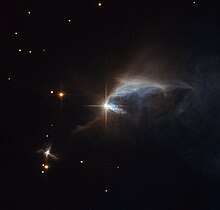Protostar
Subsequent numerical calculations[4][5][6] clarified the issue, and showed that protostars are only modestly larger than main-sequence stars of the same mass.
This basic theoretical result has been confirmed by observations, which find that the largest pre-main-sequence stars are also of modest size.
Theoretical modeling of an idealized spherical cloud initially supported only by gas pressure indicates that the collapse process spreads from the inside toward the outside.
[10] The gas that collapses toward the center of the dense core first builds up a low-mass protostar, and then a protoplanetary disk orbiting the object.
As the collapse continues, an increasing amount of gas impacts the disk rather than the star, a consequence of angular momentum conservation.
The heat from this fusion reaction tends to inflate the protostar, and thereby helps determine the size of the youngest observed pre-main-sequence stars.


